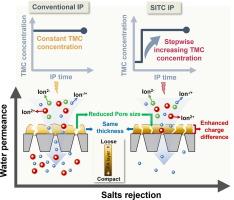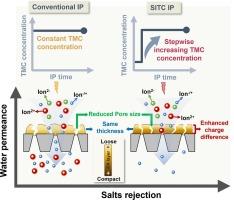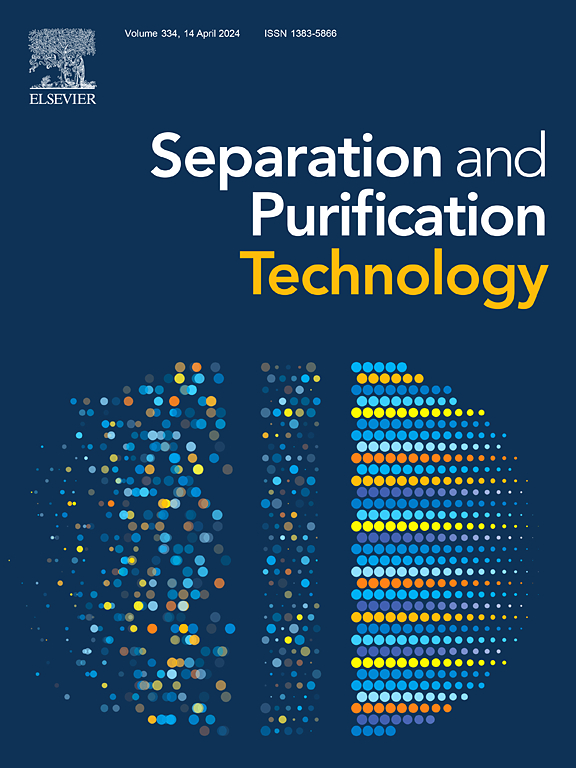在 NF 膜制造中逐步提高 TMC 浓度,以控制 PA 层厚度、紧密度和电荷分布:保持高渗透率、提高海水淡化效果以及机理启示
IF 8.1
1区 工程技术
Q1 ENGINEERING, CHEMICAL
引用次数: 0
摘要
基于哌嗪(PIP)的聚酰胺(PA)纳滤(NF)膜由于其表面带负电荷且不够紧凑,对二价阳离子的排斥有限,限制了其在各种水处理工艺中的广泛应用。为了克服这一难题,我们提出了一种新策略--在界面聚合(IP)过程中逐步提高 TMC 浓度(SITC)--来优化 PA 层结构。传统的 PA 层呈现垂直扩散结构:厚而松散的区域下是一个紧凑的阻隔区域。SITC 的调节目标是在提高密实度的同时,尽量减少水阻的增加。该调节机制表明,SITC 可在一段时间内(整个 IP 过程)和整个反应区域内调节 IP 反应。在 IP 初始阶段,SITC 降低了底部反应区的反应速率,提高了 PIP/TMC 比率,从而改善了最终底部屏障区的致密性和潜力。因此,SITC 能有效限制阳离子的渗透,将氯化镁的析出率从 33.70% 显著提高到 92.12%。在随后的扩散限制阶段,SITC 增强了对 PIP 扩散的限制,降低了最终上部疏松区的厚度和表面电位。这些有利特性使膜对 Na2SO4 的排斥率保持在较高水平(98.44%)。同时,该膜还保持了较高的透水性(13.00 L-m-2-h-1-bar-1),这归功于其 PA 层的厚度(16.69 nm)和优化的紧密度分布。这项研究通过解耦合成-性能-性能之间的关系,为定制 NF 膜的功能提供了新的机制见解。本文章由计算机程序翻译,如有差异,请以英文原文为准。


Stepwise increasing TMC concentration in NF membranes fabrication for controlled PA layer thickness, compactness, and charge distribution: Maintaining high permeance, enhancing desalination, and mechanistic insights
Piperazine (PIP)-based polyamide (PA) nanofiltration (NF) membranes exhibit limited rejection of divalent cations due to their negatively charged surfaces and insufficient compactness, restricting their broader application in various water treatment processes. To overcome this challenge, a novel strategy—stepwise increasing TMC concentration (SITC) during the interfacial polymerization (IP)—was proposed to optimize the PA layer structure. Conventional PA layer demonstrates a vertical diffusion structure: a compact barrier region underneath a thick and loose region. The regulatory goal of SITC is to enhance compactness while minimizing the increase in hydraulic resistance. The regulatory mechanism suggested SITC could regulate the IP reaction in both over time (throughout the IP process) and across the reaction region. During the initial IP stage, SITC reduced the reaction rate and increased PIP/TMC ratio in the bottom reaction zone, thereby improving the compactness and potential of final bottom barrier region. Thus, SITC can effectively restrict the permeation of cations, significantly increasing MgCl2 rejection from 33.70 % to 92.12 %. In the subsequent diffusion-limited stage, SITC enhanced the restriction on PIP diffusion, decreasing the thickness of the final upper loose region and surface potential. Those advantageous characteristics allowed the membrane to maintain a high rejection for Na2SO4 (>98.44 %). Concurrently, the membrane maintained a high water permeance (13.00 L·m−2·h−1·bar−1), attributed to the thin (16.69 nm) and optimized compactness distribution of its PA layer. This study provided a novel mechanism insight into the functional customization of NF membranes by decoupling the synthesis-property-performance relationship.
求助全文
通过发布文献求助,成功后即可免费获取论文全文。
去求助
来源期刊

Separation and Purification Technology
工程技术-工程:化工
CiteScore
14.00
自引率
12.80%
发文量
2347
审稿时长
43 days
期刊介绍:
Separation and Purification Technology is a premier journal committed to sharing innovative methods for separation and purification in chemical and environmental engineering, encompassing both homogeneous solutions and heterogeneous mixtures. Our scope includes the separation and/or purification of liquids, vapors, and gases, as well as carbon capture and separation techniques. However, it's important to note that methods solely intended for analytical purposes are not within the scope of the journal. Additionally, disciplines such as soil science, polymer science, and metallurgy fall outside the purview of Separation and Purification Technology. Join us in advancing the field of separation and purification methods for sustainable solutions in chemical and environmental engineering.
 求助内容:
求助内容: 应助结果提醒方式:
应助结果提醒方式:


